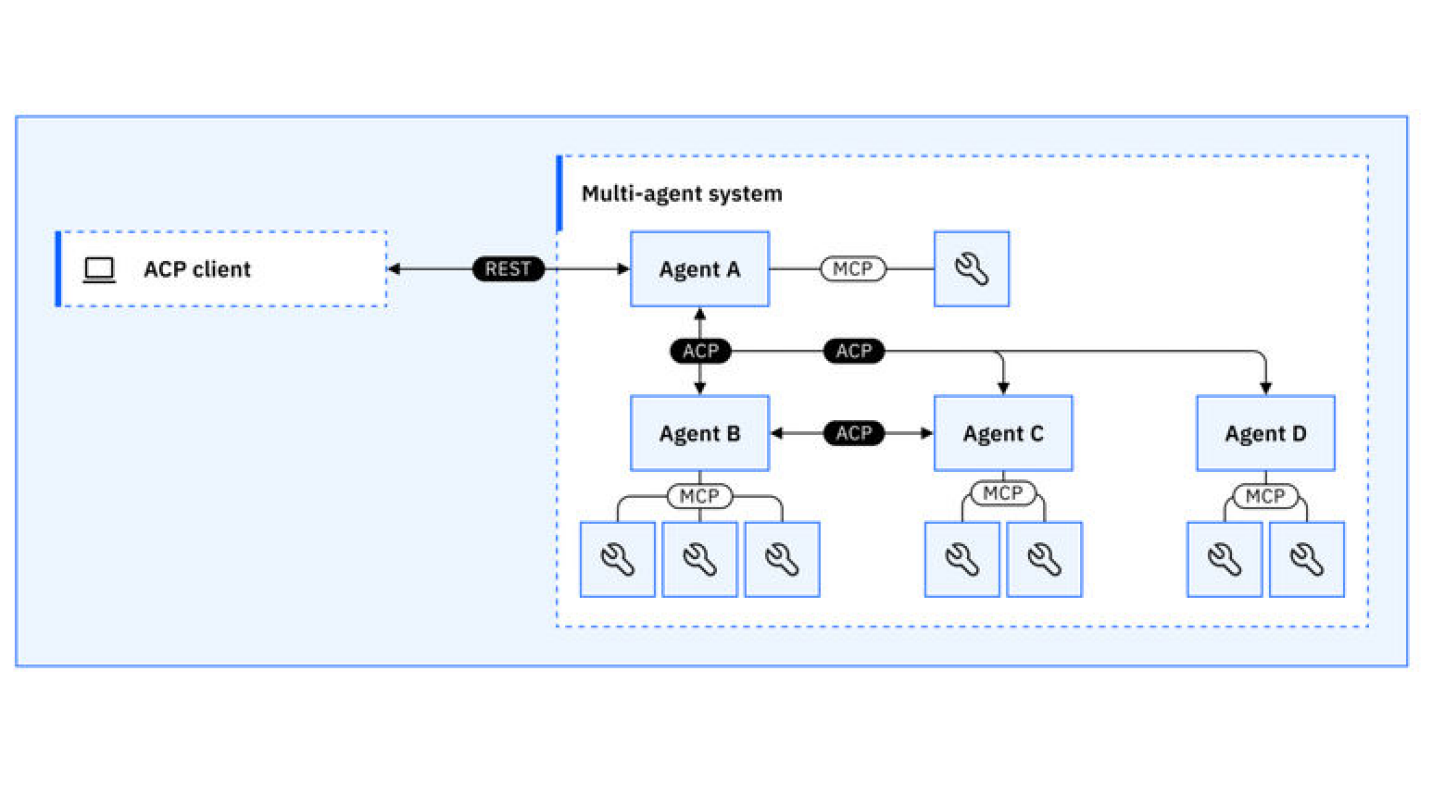

Open-sourced by IBM Research and governed under the Linux Foundation, the Agent Communication Protocol (ACP) is designed to break silos in today’s fragmented agent ecosystem.
Modern AI systems often rely on specialized modular agents (retrievers, reasoners, tool-users, classifiers, etc.). But these agents are typically locked into specific frameworks, leading to duplicated work, isolated systems, and one-off integrations that don’t scale.
ACP solves this by providing a lightweight, HTTP-native, open protocol for agent-to-agent (and agent-to-human/application) communication. Think of it as the “HTTP for AI agents.”
🌍 Why ACP?
- Fragmentation challenge: Different frameworks (LangChain, AutoGen, CrewAI, BeeAI, etc.) don’t interoperate well.
- Integration pain: Each agent often needs custom glue code.
- Innovation bottleneck: Harder to reuse, extend, or collaborate across teams and companies.
ACP standardizes how agents talk to each other while letting developers decide how they’re built.
🔗 Repo & Docs → Agent Communication Protocol GitHub
🔑 Core Features of ACP
- REST-Based Design → Built on HTTP, exposing clear endpoints for sending, receiving, and routing agent messages. Works with cURL, Postman, or any HTTP client.
- SDK-Optional → Use ACP with just HTTP requests, or streamline with SDKs for Python & TypeScript.
- Multimodal Messaging → Support for text, code, embeddings, files, and images for complex workflows (LLMs + vision + tools).
- Async by Default → Handles long-running tasks natively, with synchronous + streaming (SSE) support for low-latency apps.
- Discovery → Metadata-driven discovery of agents (even offline).
- Shared State → Long-running workflows can maintain and share context across agents.
📖 Reference: IBM Research Blog
🤝 Governance & BeeAI Ecosystem
ACP is developed under open governance (Linux Foundation).
Its primary implementation is via the BeeAI Framework, which supports:
- Building ACP-compliant agents in Python or TypeScript
- Discovery, sharing, and running of agents
- Deployment infrastructure via the BeeAI Platform
This ensures ACP isn’t just a spec—it’s a working ecosystem for production use.
🛠️ How ACP Works
- Build & Wrap your Agent → Run it as an ACP server exposing REST endpoints.
- ACP Client Requests → The client routes requests to the appropriate agent(s).
- Client-as-Agent → The ACP Client can itself act as an agent, forwarding tasks intelligently.
This allows seamless workflows, where agents collaborate in real time across modalities, systems, or even organizations.
📍 Detailed: IBM Think Overview
📌 Use Cases
- Dynamic Updating → Swap or upgrade agents without breaking integrations. (Repo Docs)
- Specialized Agents Working as a Team → A research agent, a visualization agent, and a finance agent collaborating like a human project team.
- Cross-System Workflows → Customer support agent ↔ inventory agent ↔ HR agent. Each system stays modular but interoperable.
- Inter-Organizational Collaboration → Agents across different companies securely collaborating (e.g., supply chain optimization).
📖 Read: ADaSci Practitioner’s Guide
🔄 ACP vs MCP vs A2A
| Protocol | Focus | Communication | Governance | Best For |
|---|---|---|---|---|
| MCP (Model Context Protocol, Anthropic) | Tool/context access for single agent | JSON-RPC + streaming | Proprietary (Anthropic) | Enriching agent cognition with external tools |
| ACP (Agent Communication Protocol, IBM/Linux Foundation) | Agent-to-agent interoperability | RESTful, HTTP-native | Open (Linux Foundation / BeeAI) | Local-first, low-latency, edge/team workflows |
| A2A (Agent-to-Agent, Google) | Federated inter-agent cloud cooperation | Flexible, natural HTTP/JSON | Proprietary (Google ecosystem) | Cross-vendor, cloud-native collaboration |
ACP is most practical for local-first setups where low-latency and control matter. MCP empowers single agents with context, while A2A connects cloud-based ecosystems.
📖 Analysis: Everest Group Report
🎥 Resources & Talks
- 📘 IBM Blog: What is ACP? (June 2025)
- 📘 IBM Research Blog: The Simplest Protocol for AI Agents to Work Together (May 2025)
- 📘 Towards Data Science: ACP, The Internet Protocol for AI Agents (May 2025)
- 🎥 YouTube: I Tried Getting LLMs to Work Together with ACP (May 2025)
- 🎥 AI Dev 25 – Kate Blair & Ismael Faro: The Future of Agent Interoperability (March 2025)
- 📘 Medium: The Emerging Language of Interoperable AI Agents
- 📘 ADaSci Practitioner’s Guide
- 📘 DeepLearning.AI Free Course on ACP
- 📘 arXiv: Comparative Study of MCP, A2A, ACP
🚀 Final Thoughts
ACP is to AI agents what HTTP was to the web:
a universal, open standard that enables communication, discovery, and collaboration—across frameworks, teams, and even companies.
By adopting ACP, we move closer to a world where AI agents aren’t isolated bots, but networked collaborators.
♻️ Share this if you found it insightful
Follow me (Hardik Sankhla) for more deep dives into AI agents, interoperability protocols, and ML innovation.

